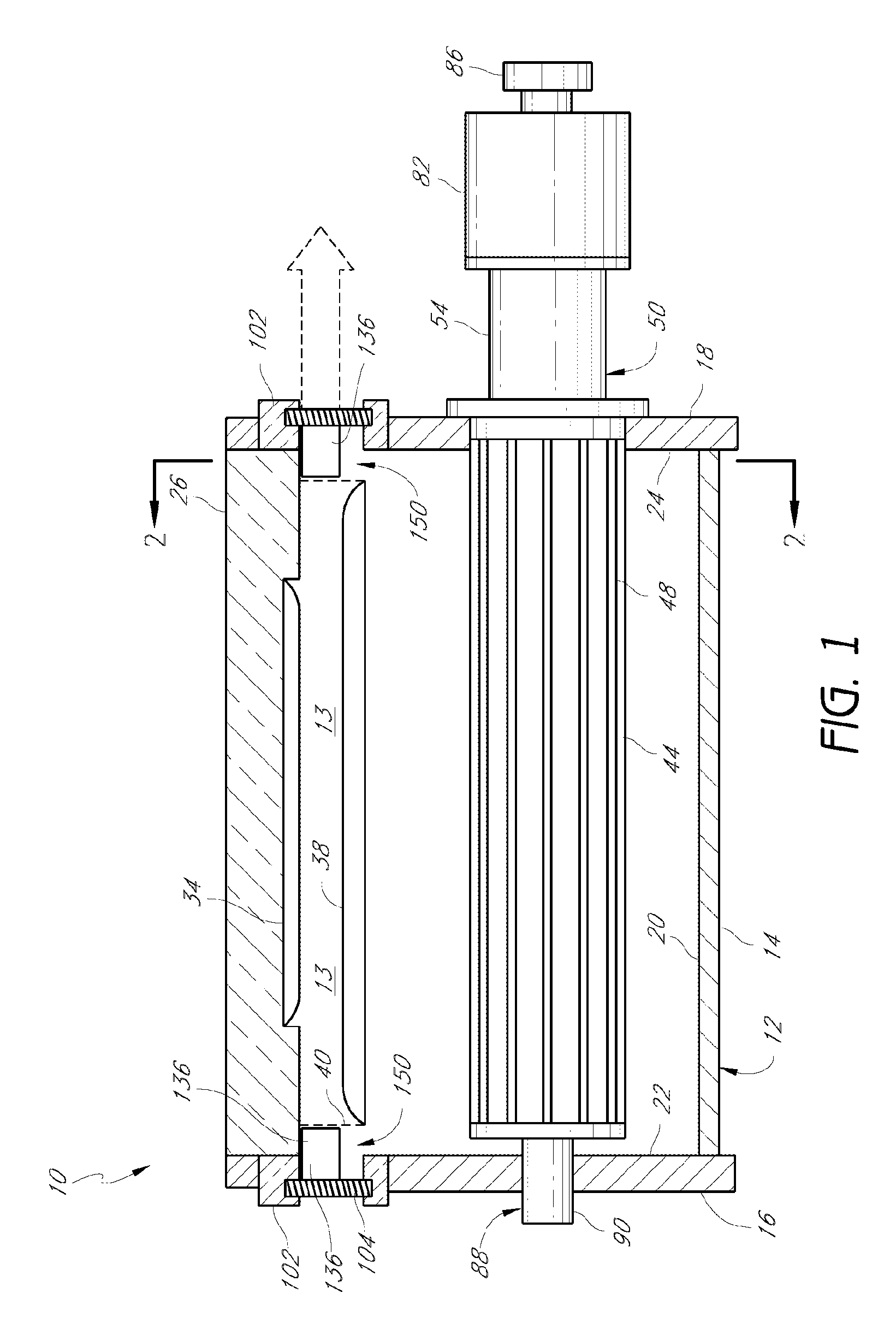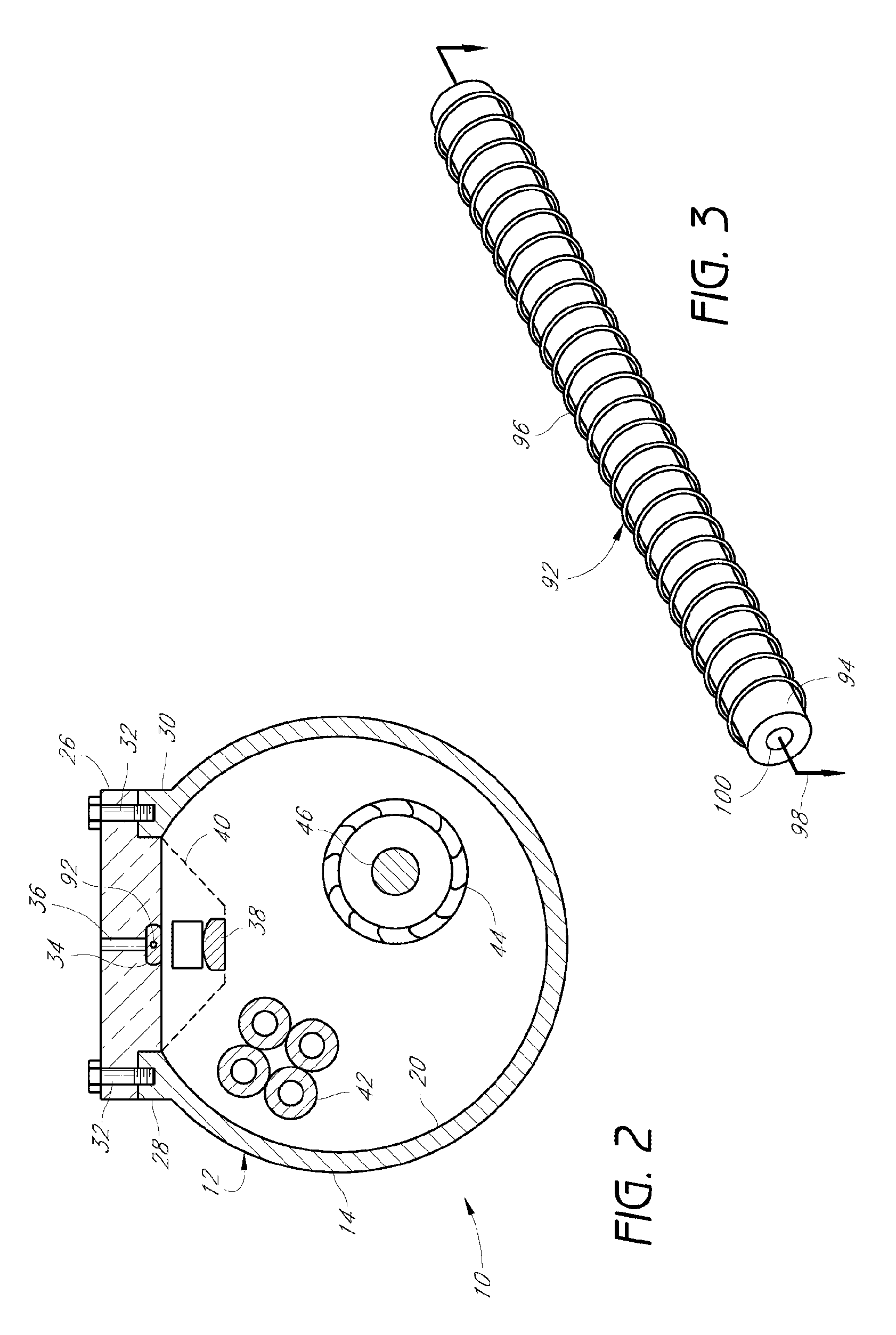[0009]One aspect of the invention comprises an excimer laser comprising a chamber for containing laser gases, a pair of electrodes, and an optical resonant cavity. The pair of electrodes energizes the gases in a region between the electrodes so as to produce light emission from the gases. The optical resonant cavity comprises a plurality of mirrors that produce a laser beam from the light emitted from the gases, the laser beam propagating in the chamber. The laser further comprises a window on the chamber for egress of the laser beam from the chamber and a fan for circulating the laser gases in the chamber. The laser additionally comprises a baffle comprising an elongated hollow member within the chamber proximal to the window. The elongate hollow member has a hollow passageway for passage of the laser beam. The elongated hollow member also has a proximal opening and a distal opening. The passageway extends from the proximal opening to the distal opening. The elongate hollow member is disposed within the chamber such that the laser beam enters the proximal opening, propagates through the hollow passageway, and exits the distal opening and through the window. The baffle reduces contamination of the window. Preferably, a substantially greater flow of the laser gases flows around the baffle than through the hollow passageway in the elongated hollow member.
[0010]Another aspect of the invention comprises an excimer laser comprising a chamber for containing laser gases, a pair of electrodes, and an optical resonant cavity. The pair of electrodes produces an electronic discharge. The electrodes are disposed with respect to each other in the chamber so as to form an active region therebetween. Light is emitted from the active region when a voltage is applied to the electrodes. The active region coincides with at least a portion of the optical resonant cavity. The light emitted from the active region resonating within the optical resonant cavity forms a laser beam. The laser further comprises a window on the chamber for egress of the laser beam from the chamber. The laser beam propagates through a portion of the window coincident with the laser beam. A fan circulates the laser gases in the chamber and through the active region. A baffle restricts the flow of gas across the portion of the window coincident with the laser beam.
[0011]Another aspect of the invention comprises a method of extending the lifetime of an excimer laser. This laser comprises a pressure vessel for containing laser gases, an active region for producing a laser beam in the pressure vessel, and at least one optical surface in the pressure vessel, a portion of which is coincident with the laser beam. The method comprises reducing the rate of flow of laser gases across the portion of the optical surface coincident with the laser beam to reduce formation of contaminants on the portion of the optical surface coincident with the laser beam.
[0012]Another aspect of the invention comprises an excimer laser comprising a pressure vessel of the type in which a halogen gas is contained, first and second electrodes, first and second reflective elements, and a fan for circulating the gases. The first and second electrodes create a laser discharge between the electrodes. The first and second reflective elements form a laser cavity in the pressure vessel. The laser discharge produces a laser beam in the laser cavity. The first and second optical surfaces are oppositely situated in the pressure vessel. The laser beam propagates between these first and second optical surfaces. The excimer laser further comprises flow control surfaces within the pressure vessel to direct the flow of gases circulating within the pressure vessel away from portions of the optical surfaces on which the laser beam is incident such that the rate at which particulates are deposited on such surfaces where the laser beam is incident is substantially reduced. The portions of the pressure vessel, first and second electrodes, fan, and flow control surfaces that are in contact with the halogen gas are fabricated substantially of materials that react with the halogen gas to form stable reaction products having vapor pressures of less than about 10−6 torr, at normal operating temperatures, such that the lifetime of the excimer laser is increased by not adding or creating any substantial quantity of laser contamination. Contamination is therefore substantially reduced.
[0013]Another aspect of the invention comprises an excimer laser comprising a pressure vessel for containing a halogen gas, first and second electrodes, first and second optical elements, and first and second flow-redirecting surfaces. The first and second electrodes are located within the pressure vessel. The first and second electrodes are separated such that a voltage applied between the first and second electrodes produces a gas discharge that emits light. The first and second optical elements are located at opposite ends of the pressure vessel. The first and second optical elements are disposed with respect to the separation between the first and second electrodes to receive the emitted light. The first and second flow-redirecting surfaces are located adjacent to the first and second optical elements, respectively. The flow-redirecting surfaces reduce the rate at which gases in the pressure vessel flow adjacent the optical component where the optical component receives the emitted light. These flow-redirecting surfaces may comprise baffles at optical windows on the pressure vessel.
 Login to View More
Login to View More  Login to View More
Login to View More 


